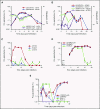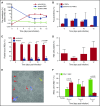Platelets activate a pathogenic response to blood-stage Plasmodium infection but not a protective immune response
- PMID: 28096086
- PMCID: PMC5364340
- DOI: 10.1182/blood-2016-08-733519
Platelets activate a pathogenic response to blood-stage Plasmodium infection but not a protective immune response
Abstract
Clinical studies indicate that thrombocytopenia correlates with the development of severe falciparum malaria, suggesting that platelets either contribute to control of parasite replication, possibly as innate parasite killer cells or function in eliciting pathogenesis. Removal of platelets by anti-CD41 mAb treatment, platelet inhibition by aspirin, and adoptive transfer of wild-type (WT) platelets to CD40-KO mice, which do not control parasite replication, resulted in similar parasitemia compared with control mice. Human platelets at a physiologic ratio of 1 platelet to 9 red blood cells (RBCs) did not inhibit the in vitro development or replication of blood-stage Plasmodium falciparum The percentage of Plasmodium-infected (iRBCs) with bound platelets during the ascending parasitemia in Plasmodium chabaudi- and Plasmodium berghei-infected mice and the 48-hour in vitro cycle of P falciparum was <10%. P chabaudi and P berghei iRBCs with apoptotic parasites (TdT+) exhibited minimal platelet binding (<5%), which was similar to nonapoptotic iRBCs. These findings collectively indicate platelets do not kill bloodstage Plasmodium at physiologically relevant effector-to-target ratios. P chabaudi primary and secondary parasitemia was similar in mice depleted of platelets by mAb-injection just before infection, indicating that activation of the protective immune response does not require platelets. In contrast to the lack of an effect on parasite replication, adoptive transfer of WT platelets to CD40-KO mice, which are resistant to experimental cerebral malaria, partially restored experimental cerebral malaria mortality and symptoms in CD40-KO recipients, indicating platelets elicit pathogenesis and platelet CD40 is a key molecule.
© 2017 by The American Society of Hematology.
Figures






Comment in
-
Platelets: killers of parasites or patients?Blood. 2017 Mar 23;129(12):1571-1572. doi: 10.1182/blood-2017-01-764621. Blood. 2017. PMID: 28336729 No abstract available.
Similar articles
-
Platelets kill intraerythrocytic malarial parasites and mediate survival to infection.Science. 2009 Feb 6;323(5915):797-800. doi: 10.1126/science.1166296. Science. 2009. PMID: 19197068
-
IL-12 is required for antibody-mediated protective immunity against blood-stage Plasmodium chabaudi AS malaria infection in mice.J Immunol. 2002 Feb 1;168(3):1348-55. doi: 10.4049/jimmunol.168.3.1348. J Immunol. 2002. PMID: 11801675
-
Platelets kill circulating parasites of all major Plasmodium species in human malaria.Blood. 2018 Sep 20;132(12):1332-1344. doi: 10.1182/blood-2018-05-849307. Epub 2018 Jul 19. Blood. 2018. PMID: 30026183 Free PMC article.
-
Malaria blood-stage infection and its control by the immune system.Folia Biol (Praha). 2000;46(6):210-8. Folia Biol (Praha). 2000. PMID: 11140853 Review.
-
The role of platelets in the pathogenesis of cerebral malaria.Cell Mol Life Sci. 2010 Feb;67(4):557-68. doi: 10.1007/s00018-009-0211-3. Epub 2009 Nov 29. Cell Mol Life Sci. 2010. PMID: 20091081 Free PMC article. Review.
Cited by
-
Citrulline protects mice from experimental cerebral malaria by ameliorating hypoargininemia, urea cycle changes and vascular leak.PLoS One. 2019 Mar 8;14(3):e0213428. doi: 10.1371/journal.pone.0213428. eCollection 2019. PLoS One. 2019. PMID: 30849122 Free PMC article.
-
Cerebral Malaria in Mouse and Man.Front Immunol. 2018 Sep 10;9:2016. doi: 10.3389/fimmu.2018.02016. eCollection 2018. Front Immunol. 2018. PMID: 30250468 Free PMC article. Review.
-
The Ins and Outs of Cerebral Malaria Pathogenesis: Immunopathology, Extracellular Vesicles, Immunometabolism, and Trained Immunity.Front Immunol. 2019 Apr 17;10:830. doi: 10.3389/fimmu.2019.00830. eCollection 2019. Front Immunol. 2019. PMID: 31057552 Free PMC article. Review.
-
The mRNA content of plasma extracellular vesicles provides a window into molecular processes in the brain during cerebral malaria.Sci Adv. 2024 Aug 16;10(33):eadl2256. doi: 10.1126/sciadv.adl2256. Epub 2024 Aug 16. Sci Adv. 2024. PMID: 39151016 Free PMC article.
-
Accelerator or Brake: Immune Regulators in Malaria.Front Cell Infect Microbiol. 2020 Dec 10;10:610121. doi: 10.3389/fcimb.2020.610121. eCollection 2020. Front Cell Infect Microbiol. 2020. PMID: 33363057 Free PMC article. Review.
References
-
- van der Heyde HC, Nolan J, Combes V, Gramaglia I, Grau GE. A unified hypothesis for the genesis of cerebral malaria: sequestration, inflammation and hemostasis leading to microcirculatory dysfunction. Trends Parasitol. 2006;22(11):503-508. - PubMed
-
- McMorran BJ, Wieczorski L, Drysdale KE, et al. . Platelet factor 4 and Duffy antigen required for platelet killing of Plasmodium falciparum. Science. 2012;338(6112):1348-1351. - PubMed
-
- McMorran BJ, Marshall VM, de Graaf C, et al. . Platelets kill intraerythrocytic malarial parasites and mediate survival to infection. Science. 2009;323(5915):797-800. - PubMed
-
- Peyron F, Polack B, Lamotte D, Kolodie L, Ambroise-Thomas P. Plasmodium falciparum growth inhibition by human platelets in vitro. Parasitology. 1989;99(Pt 3):317-322. - PubMed
Publication types
MeSH terms
Substances
Grants and funding
LinkOut - more resources
Full Text Sources
Other Literature Sources
Medical
Molecular Biology Databases
Research Materials

